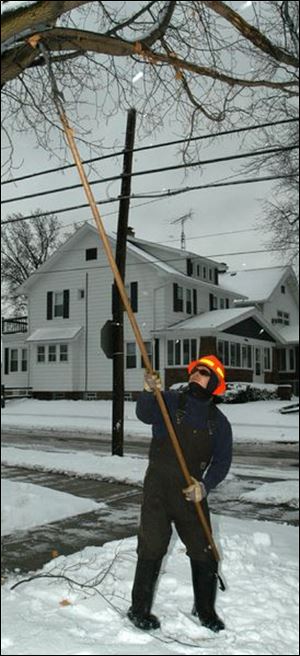
Help trees withstand ice damage
1/7/2004Wet, cold winter weather can force some branches to hang low with a coating of ice. Most limbs can handle 1/4 inch of ice or less. But if that sheath becomes a limb-breaking 1/2 inch, the tree's life could be in danger.
"Ice ends up exploiting the weaknesses in a tree," says Pat O'Brien, forestry inspector for the city of Toledo. "Heavy lateral limbs, multiple trunks, dense crowns, and dead sections are the most vulnerable to ice and snow damage. Plus any pockets or hidden pockets of decay become a possible breaking point."
Mr. O'Brien says ice buildup on a tree puts stress on the trunk. If the trunk is partially decayed, there isn't enough healthy wood to support the ice-covered limbs and they break. He says trees can handle some broken limbs, but 50 to 75 percent breakage can kill the trees.

David Villarreal of the city of Toledo forestry division trims a tree in South Toledo after a weekend storm.
How do you keep tree limbs from breaking under this added winter weight? Mr. O'Brien says bracing won't help. He recommends keeping them healthy and pruning out the tree's weaknesses. Remove diseased and broken limbs first. "These limbs most likely won't repair themselves, so get them out of there. They will attract fungi and insects that can be even more damaging to your tree."
If a tree is growing more than one dominant branch at the top, that could be a problem in the future. That dominant branch is called the leader. A tree gets its basic shape as the leader grows taller. More than one leader creates a weakness where the leaders meet, and eventually can split a tree in half.
But, he says, you have to be realistic. "It's tough to get rid of a multiple leader if it is six feet off the ground. You need to prune your trees early and keep them healthy over the years."
When pruning a tree, always start with clean tools, then look for the branch's collar. It is a swollen part of the branch near the trunk. Make the first cut underneath the branch, but don't cut all the way through. Make the second cut on top of the branch just in front of the undercut. The heavy branch will drop off. You aren't finished yet. Make the final cut closer to the collar, following the same angle, leaving only a short stub. Mr. O'Brien says pruning paint isn't recommended. A tree will heal quicker without it.
If large portions of the tree have broken off, contact a certified arborist to see if it is sound.